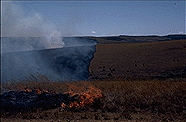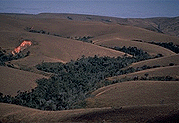

In the central part of the Madagascar, one now sees a desolate, open landscape, with small, remnant stands of evergreen forest (thalwegs) restricted to valleys and other protected sites, surrounded by vast expanses of monotonous secondary grassland.
These areas are almost totally devoid of trees, and have been subjected to regular annual burning for centuries, resulting in an irreversibly impoverished landscape.
A few remnant areas with rich, diverse evergreen forest remain in the central part of the country, such as at the Ambohitantely Special Reserve north of Antananarivo,
or in a small area south of Ambositra.
Specialized vegetation types are associated with edaphic conditions, such as those found on inselbergs (large granitic domes), in south-central Madagascar,
or at Isalo National Park in the southwest.
In poorly drained areas, edaphic swamps (marécages édaphiques) occur with characteristic plants such as the palm Ravenea rivularis and species of "coniferoid" Pandanus.
And even in the midst of dense closed forest, such as at Ranomafana National Park, one can find natural areas dominated by grasses, sedges, mosses, and other herbaceous species.